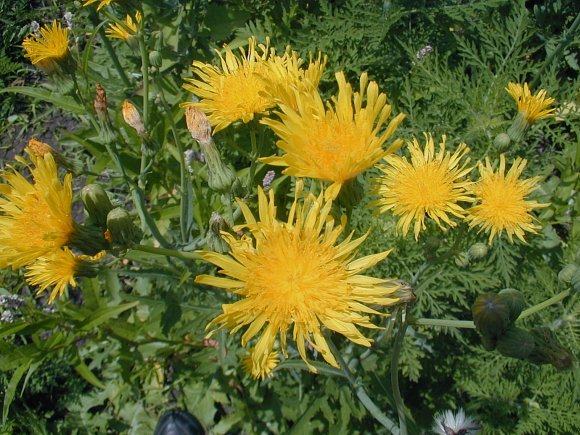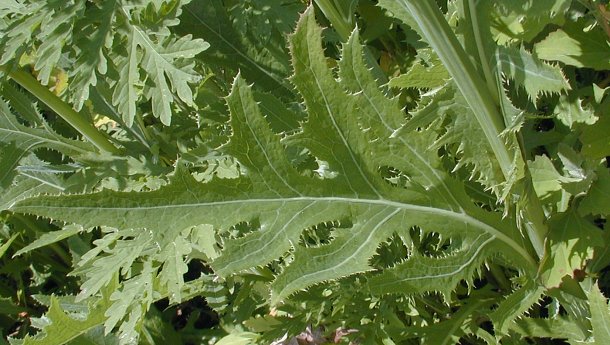Description: This herbaceous perennial plant is 2-4' tall, branching occasionally in the upper half. The dull green stems are hairless. The alternate leaves are up to 12" long and 3½" across, becoming smaller as they ascend the stems. Most of these leaves are located in the lower half of the plant. They are lanceolate, oblanceolate, or ovate in overall shape, but usually have about 2-5 lobes with pointed tips on each side (pinnatifid). Some of the upper leaves may be unlobed, and occasionally there are plants without significant lobes on the leaves. The margins are dentate-prickly. The upper surface of each leaf is glabrous, while the lower mid-rib is without prickles. At the base of each leaf, there is a pair of small basal lobes that clasp the stem. These basal lobes are usually rather small and well-rounded.

The upper stems
terminate in flower stalks of composite flowers. These stalks are quite
long and have few leaves. These stalks branch sparingly and produce
clusters of composite flowers. Each composite flower is about 1–1½"
across, consisting of numerous yellow ray florets. The base of the
flower is covered with overlapping green bracts – it is about ¾" in
length. In variety glabrescens, both the flowering
stalks and bracts are hairless. However, the typical variety has
flowering stalks and bracts with glandular hairs. The blooming period
occurs during the summer and lasts about 1-2 months. There is a
pleasant floral scent. Each ray floret is replaced by a rather flat
achene that is tapered on both ends and has several longitudinal ribs
along its length. The achenes have tufts of fine white hairs and are
distributed by the wind. The root system consists of a stout taproot
that can run 9 ft. into the ground, and it produces long spreading
rhizomes. This plant frequently forms clonal colonies.
Cultivation:
The species prefers full sun, mesic conditions, and rich loamy soil. It
is an aggressive spreader that can be hard to get rid off because even
small pieces of the extensive root system can regenerate new plants.
Seeds can remain viable in the ground for several years.
Range & Habitat:
The glabrous variety of Perennial Sowthistle is common in northern
Illinois, occasional in central Illinois, and rare or absent in
southern Illinois (see Distribution
Map). It is more common than the typical variety in the
state. Both varieties of this species are adventive from Eurasia.
Habitats include cropland, weedy meadows, edges of gardens, areas along
roads, and miscellaneous waste areas. This species prefers disturbed
areas. So far, it has not invaded high quality natural areas to any
major extent.

Faunal
Associations:
According to Müller (1873/1883) in Germany, the nectar and pollen of
the flowerheads attract long-tongued bees, short-tongued bees, drone
flies (Eristalis
spp.), skippers, and beetles. Among the bees,
are such floral visitors as bumblebees, honeybees, dagger bees,
Halictid
bees, cuckoo bees (Nomada
spp.), mason bees (Osmia
spp.), and leaf-cutting bees (Megachile spp.).
Several aphids feed on the plant sap of Perennial Sowthistle and other
sowthistles (Sonchus spp.).
These species include Hyperomyzus
lactucae (Currant-Sowthistle Aphid), Pemphigus bursarius
(Poplar-Lettuce Aphid), and Uroleucon
sonchi (Large Sowthistle Aphid); see Blackman &
Eastop (2013). The larvae of Aulacidea
tumida (Lettuce Tumor Gall Wasp) form galls along the
stems of these plants, while Melanoplus
bivittatus
(Two-striped Grasshopper) feeds on the foliage or flowerheads (Felt,
1917; Wyoming Agr. Exp. Station, 1994). Among vertebrate animals, the
Franklin Ground Squirrel eats the leaves, buds, and flowerheads of
sowthistles; the Ruffed Grouse browses on the leaves; the Eastern
Goldfinch eats the seeds; and the White-tailed Deer browses on the
foliage and mature flowerheads, spreading the seeds into new locations
(Ostroff & Finck, 2003; Bennetts, 1900; Martin et al.,
1951/1961; Myers et al., 2004).
Photographic Location:
An abandoned vegetable garden in Urbana, Illinois.
Comments: Perennial Sowthistle produces attractive dandelion-like flowers on long stalks. It is the only Sonchus sp. (Sowthistle) within the state that is perennial in habit, and its flowerheads are larger in size (at least 1" across) than the others. The flowerheads of Sonchus asper (Prickly Sowthistle) and Sonchus oleraceus (Annual Sowthistle) are ¾" across or less. The basal lobes on the leaves of Perennial Sowthistle are usually well-rounded and small, while the basal lobes of Prickly Sowthistle are well-rounded, but large, and the basal lobes of Annual Sowthistle have sharp angles. The typical variety of the Perennial Sowthistle is a hairier plant than var. glabrescens. Because the latter is sometimes considered a distinct species, it is occasionally referred to as Sonchus uliginosus.